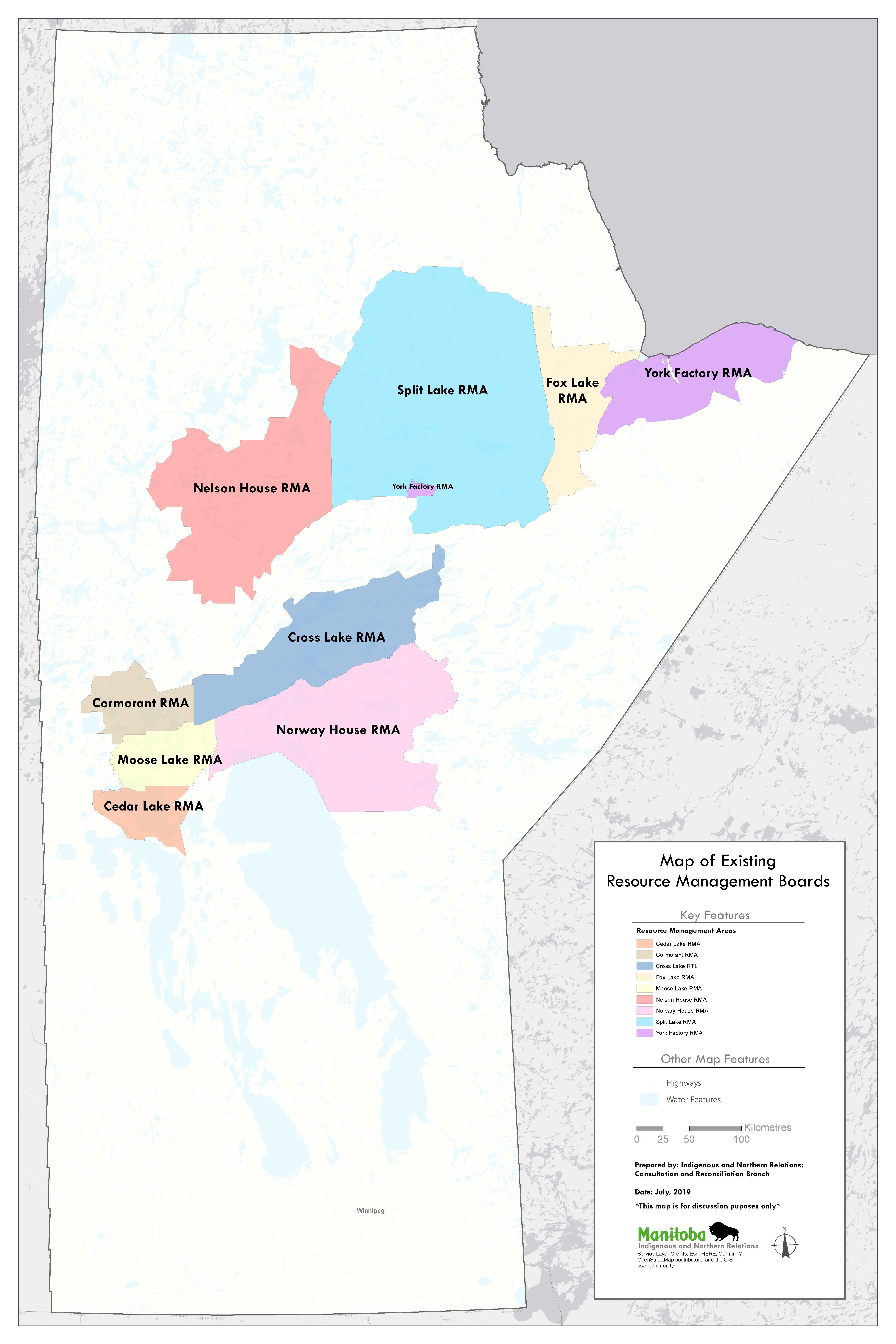Resource Management Boards
Through the respective adverse affects settlement agreements (ex: Northern Flood Agreement, Grand Rapids Forebay and others), Resource Management Boards (RMBs) were established to co-manage the natural resources in defined areas (Resource Management Areas). Manitoba Indigenous Relations serves as the provincial lead in the management and implementation of the RMBs established under these agreements. Each of the ten existing RMBs are mandated to develop and implement land use plans and resource management plans.
The boards are responsible for approximately 35 million acres or 22 per cent of Manitoba’s Crown land base.

Prepared by: Indigenous and Northern Relations;
Agreements Management and Aboriginal Consultations
Source: Manitoba GIS Database
Date: July 2019
* This map is not final and is for discussion / illustrative purposes only *
Full size image
| RMA or RTL Name | Area (km2) | Area (Acres) |
|---|---|---|
| Cedar Lake RMA | 3759.38 | 928962 |
| Cormorant RMA | 4944.76 | 1221880 |
| Cross Lake RTL | 14676.3 | 3626580 |
| Fox Lake RMA | 8029.78 | 1984200 |
| Inuit-Dene Sub-Arctic RMA (Proposed) | 67511.81 | 16682530 |
| Moose Lake RMA | 4872.91 | 1204120 |
| Nelson House RMA | 22883.7 | 5654670 |
| Norway House RMA | 22012.1 | 5439300 |
| Opaskweyak Cree Nation RMA | 6212.86 | 1535230 |
| South indian Lake RMA (Proposed) | 33906.61 | 8378505 |
| Split Lake RMA | 43168.7 | 10667200 |
| York Factory RMA | 10623.96 | 2625230 |
| Total Area | 242602.87 | 59948407 |
| Total Area (excluding proposed) | 141184.45 | 34887372 |
| % of Manitoba land Base | 37.33% | - |
| % of Manitoba Land Base (excluding proposed) | 21.72% | - |
The ten existing RMBs include:
- Split Lake (involving Tataskweyak Cree Nation) (PDF)
- Nelson House (involving Nisichawayasihk Cree Nation) (PDF)
- York Factory (involving York Factory First Nation) (PDF)
- Norway House (involving Norway House Cree Nation and Norway House Community Council) (PDF)
- Cormorant (involving the Cormorant Community Council) (PDF)
- Cedar Lake (involving Chemawawin First Nation and Easterville Community Council) (PDF)
- Fox Lake (involving Fox Lake Cree Nation)
- Moose Lake (involving Mosakahiken Cree Nation and Moose Lake Community) (PDF)
- Cross Lake (involving the Community of Cross Lake Community Council) (PDF)
- OCN (involving Opaskwayak Cree Nation)
Each RMB is represented by approximately eight to 10 people, including members from the community (First Nation or Northern Affairs community) and from the Manitoba government. Each RMB meets a minimum of four times per year.
Each RMB is unique in terms of its focus and priorities which are based on the area, economy and geographic location. In 2015, the RMB priorities included:
- land and resource use planning
- water management
- commercial and domestic harvesting activities
- mineral development activities
- forestry
- wildlife management
The RMBs provide for effective communication with community members and other stakeholders through community meetings, annual reports, newsletters and developing working relationships with government agencies and other organizations.
2017 Manitoba Land Use Planning Gathering, Conference and Tradeshow “What We Heard” summary report
The first Manitoba Land Use Planning Gathering, Conference and Tradeshow took place in Winnipeg, Manitoba in January/February 2017. The purpose of the event was to share information and build capacity, relationships and networks among resource management/stewardship boards, governments and businesses. Indigenous and Northern Relations (INR) has completed a What We Heard summary report and the outcome highlights the success of this first event with positive feedback and a greater understanding of land use planning in Manitoba.

Conference and Tradeshow
"What We Heard" Summary Report (PDF)

